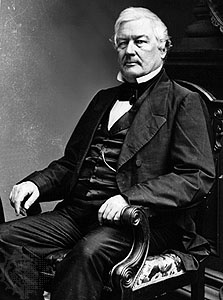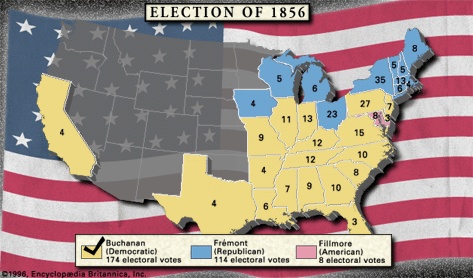Fillmore, Millard
president of United States
born January 7, 1800, Locke Township, New York, U.S.
died March 8, 1874, Buffalo
 13th president of the United States (1850–53), whose insistence on federal enforcement of the Fugitive Slave Act (Fugitive Slave Acts) of 1850 alienated the North and led to the destruction of the Whig Party. Elected vice president in 1848, he became chief executive on the death of President Zachary Taylor (Taylor, Zachary) (July 1850). (For a discussion of the history and nature of the presidency, see presidency of the United States of America.)
13th president of the United States (1850–53), whose insistence on federal enforcement of the Fugitive Slave Act (Fugitive Slave Acts) of 1850 alienated the North and led to the destruction of the Whig Party. Elected vice president in 1848, he became chief executive on the death of President Zachary Taylor (Taylor, Zachary) (July 1850). (For a discussion of the history and nature of the presidency, see presidency of the United States of America.)Fillmore was born in a log cabin to a poor family and was apprenticed to a wool carder at age 15. He received little formal education until he was 18, when he managed to obtain six consecutive months of schooling. Shortly afterward he secured his release from apprenticeship and started work in a law office, and in 1823 he was admitted to the bar. He married his first wife, Abigail Powers (Abigail Fillmore (Fillmore, Abigail)), in 1826.
 Fillmore entered politics in 1828 as a member of the democratic and libertarian Anti-Masonic Movement and Anti-Masonic Party. In 1834 he followed his political mentor, Thurlow Weed (Weed, Thurlow), to the Whigs and was soon recognized as an outstanding leader of the party's Northern wing. Following three terms in the New York state assembly (1829–32), he was elected to Congress (1833–35, 1837–43), where he became a devoted follower of Senator Henry Clay (Clay, Henry). Losing the New York gubernatorial election in 1844, he was easily elected the first state comptroller three years later. At the national Whig convention in 1848, Zachary Taylor (Taylor, Zachary), hero of the Mexican War (Mexican-American War) (1846–48), was nominated for president and Fillmore for vice president, largely through Clay's sponsorship.
Fillmore entered politics in 1828 as a member of the democratic and libertarian Anti-Masonic Movement and Anti-Masonic Party. In 1834 he followed his political mentor, Thurlow Weed (Weed, Thurlow), to the Whigs and was soon recognized as an outstanding leader of the party's Northern wing. Following three terms in the New York state assembly (1829–32), he was elected to Congress (1833–35, 1837–43), where he became a devoted follower of Senator Henry Clay (Clay, Henry). Losing the New York gubernatorial election in 1844, he was easily elected the first state comptroller three years later. At the national Whig convention in 1848, Zachary Taylor (Taylor, Zachary), hero of the Mexican War (Mexican-American War) (1846–48), was nominated for president and Fillmore for vice president, largely through Clay's sponsorship. Cabinet of President Millard FillmoreFillmore believed that Whig success at the polls heralded the rise of a truly national party that would occupy a middle ground between sectional extremists of both North and South. This outlook was embodied in Clay's Compromise of 1850 (1850, Compromise of), which sought to appease both sides on the slavery issue. Fillmore, though personally opposed to slavery, supported the compromise as necessary to preserving the Union. When the legislation was finally passed two months after Taylor's death, the new President Fillmore felt obligated to respect the provision that required the federal government to aid in the capture and return of runaway slaves to their former owners (the Fugitive Slave Act (Fugitive Slave Acts) of 1850), and he publicly announced that, if necessary, he would call upon the military to aid in the enforcement of this statute. Although this section of the compromise assuaged the South and had the effect of postponing the Civil War for 10 years, it also meant political death for Fillmore because of its extreme unpopularity in the North. (The table provides a list of cabinet members in the administration of President Millard Fillmore. Cabinet of President Millard Fillmore)
Fillmore was an early champion of American commercial expansion in the Pacific, and in 1853 he sent a fleet of warships, under the command of Commodore Matthew C. Perry (Perry, Matthew C), to Japan to force its shogunate government to alter its traditional isolationism and enter into trade and diplomatic relations with the United States (see primary source document: A Golden Rule for Foreign Affairs (Millard Fillmore: A Golden Rule for Foreign Affairs)). The resulting Treaty of Kanagawa (Kanagawa, Treaty of) (1854) led to similar agreements between Japan and other Western powers and marked the beginning of Japan's transformation into a modern state.

 In 1852 Fillmore was one of three presidential candidates of a divided Whig Party in its last national election, which it lost. He ran again in 1856 as the candidate of the Know-Nothing party (also known as the American Party), finishing third behind Democrat James Buchanan (Buchanan, James) and Republican John C. Frémont (Frémont, John C). Fillmore then retired to Buffalo, where he became a leader in the city's civic and cultural life. In 1858, some five years after the death of his wife Abigail, he married Caroline Carmichael McIntosh.
In 1852 Fillmore was one of three presidential candidates of a divided Whig Party in its last national election, which it lost. He ran again in 1856 as the candidate of the Know-Nothing party (also known as the American Party), finishing third behind Democrat James Buchanan (Buchanan, James) and Republican John C. Frémont (Frémont, John C). Fillmore then retired to Buffalo, where he became a leader in the city's civic and cultural life. In 1858, some five years after the death of his wife Abigail, he married Caroline Carmichael McIntosh.Additional Reading
Documents written by Millard Fillmore are collected in Frank H. Severance (ed.), Millard Fillmore Papers, 2 vol. (1907, reprinted 1970). Works dealing with the life and presidency of Fillmore include Robert J. Rayback, Millard Fillmore (1959, reissued 1992); Benson Lee Grayson, The Unknown President (1981); and Elbert B. Smith, The Presidencies of Zachary Taylor & Millard Fillmore (1988).
- Grover Cleveland: Second Inaugural Address
- Grove, Sir George
- Grove, Sir William Robert
- Groves, Leslie Richard
- growing season
- growth
- growth hormone
- growth medium
- growth ring
- Grozny
- Grubbs, Robert H.
- Grubenmann, Hans Ulrich; and Grubenmann, Johannes
- Grub Street
- Grudziądz
- Gruen, Victor
- Gruffydd, William John
- gruiform
- Grumbach, Wilhelm von
- Grumiaux, Arthur, Baron
- Grumman, Leroy Randle
- Grundschule
- Grundtvig, N.F.S.
- Grundy, Mrs.
- grunge
- grunion